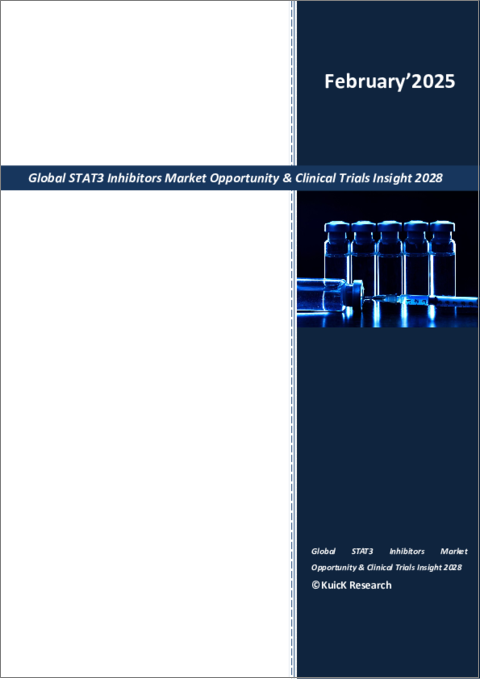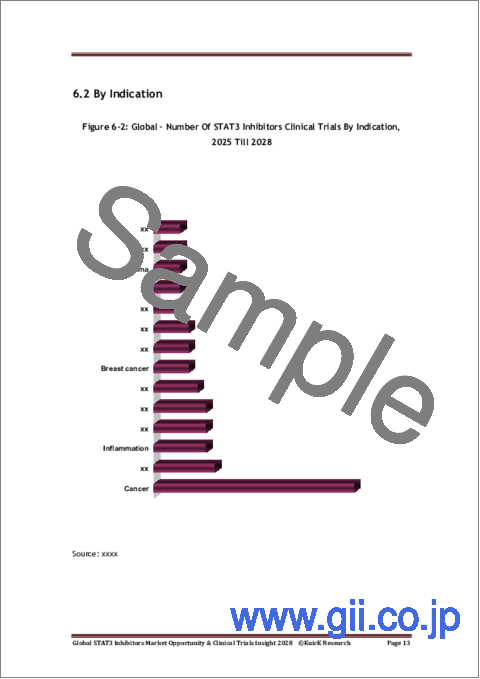|
|
市場調査レポート
商品コード
1658728
STAT3阻害剤の世界市場:市場の機会と臨床試験に関する洞察(2028年)Global STAT3 Inhibitors Market Opportunity & Clinical Trials Insight 2028 |
||||||
|
|||||||
| STAT3阻害剤の世界市場:市場の機会と臨床試験に関する洞察(2028年) |
|
出版日: 2025年02月01日
発行: KuicK Research
ページ情報: 英文 100 Pages
納期: 即日から翌営業日
|
全表示
- 概要
- 図表
- 目次
STAT3阻害剤の進歩は、がん治療および関連領域において、有望でありながらほとんど未開拓の市場において大きな機会をもたらします。STAT3は、細胞増殖、生存、免疫反応、炎症など、様々な細胞プロセスの管理において極めて重要です。その異常な活性は、複数の疾患、特にがんの発症と進行に関連しています。がんの動態におけるその本質的な機能を考えると、STAT3を標的とすることは、腫瘍の増殖、転移、免疫回避、治療に対する抵抗性など、いくつかの重要な腫瘍形成メカニズムに影響を与える、際立ったチャンスを提供することになります。STAT3阻害剤はかなり有望であるにもかかわらず、STAT3阻害剤の市場はまだ初期段階にあり、承認された薬剤はGolotimod1種類しかなく、その使用は入手しやすさ、適用しやすさの点で制限されています。
効果的ながん治療に対する差し迫った需要から、製薬会社や研究機関の間では、STAT3阻害のような革新的な戦略の調査に関心が集まっています。STAT3を標的とする薬剤の創製は、薬剤耐性や重大な副作用を頻繁に引き起こす化学療法など、既存のがん治療に関連する多くの課題を克服する手段と考えられています。腫瘍の進展と転移に大きく寄与するSTAT3は、がん細胞の生存と増殖を阻害する魅力的な標的です。とはいえ、STAT3阻害剤の商業化への道には、その有効性、安全性、良好な薬物動態学的特性を実証する必要性などの障害がつきまとい、臨床試験における数多くの候補化合物の進展を妨げています。とはいえ、有効なSTAT3阻害剤はがん治療の転帰を著しく改善し、薬剤耐性や進行した病期のために選択肢が限られている患者に新たな選択肢を提供する可能性があるため、市場全体の可能性は依然として大きいものとなっています。
STAT3阻害は、がんのみならず、様々な自己免疫疾患や炎症性疾患に対する有望な治療アプローチとして浮上しています。STAT3が免疫応答を媒介し、炎症を制御する役割を果たすことから、STAT3は関節リウマチ、炎症性腸疾患、乾癬などの疾患に対する重要な標的となっています。これらの疾患におけるSTAT3の調節異常は、慢性炎症、組織損傷、自己免疫の発症につながります。その結果、STAT3阻害剤の市場は、腫瘍学にとどまらず、自己免疫疾患や炎症性疾患の広範な疾患を包含するまでに拡大する可能性があり、それによってこれらの薬剤の治療用途が大幅に拡大することになります。さらに、STAT3阻害によって免疫反応を調節する能力は、抗ウイルス免疫におけるSTAT3の役割が注目されているウイルス感染症など、他の領域においても重要な意味を持つ可能性があります。このように治療用途の可能性が広がっていることから、STAT3阻害剤は、多くの深刻かつ広範な健康問題に適用可能な汎用性の高い薬剤クラスと位置づけられています。
その結果、STAT3阻害剤の市場は、ドラッグデリバリーおよび製剤化技術における革新の機会を提示しています。低分子やペプチドを利用する従来の方法では、バイオアベイラビリティ、安定性、細胞への取り込みに関する課題に直面してきました。そのため研究者らは、STAT3阻害剤の治療効果を高めるために、ナノ粒子ベースの送達システム、siRNAベースの阻害剤、オンコライトウイルスなどの先進戦略を模索しています。これらの新規デリバリー法は、腫瘍細胞や特定の組織をより的確に標的化し、オフターゲット効果を減少させ、薬剤全体の安定性を向上させることにより、治療の精度と有効性を改善することを目的としています。これらの革新的なアプローチはまだ開発の初期段階にあるが、従来のSTAT3阻害剤に関連する限界に対処する可能性を提供し、より効果的で標的を絞った治療オプションへの道を開くものです。
技術的課題にもかかわらず、STAT3阻害剤の潜在的市場は広大であり、ほとんど未開拓です。様々な疾患メカニズム、特にがんにおけるSTAT3の必須機能を考慮すると、STAT3を標的とする効果的な薬剤の創出は、広範な疾患の治療に革命をもたらす可能性があります。研究が進み、ドラッグデリバリーやターゲティングを強化する革新的な戦略が登場するにつれて、STAT3阻害剤の市場は大きく成長し、製薬部門から多大な投資と注目を集めることが予想されます。これらの阻害剤が成功を収めれば、がんや自己免疫疾患、その他の疾患に対する治療法を再構築する可能性があり、この分野は非常に収益性の高い、まだほとんど未開拓の医薬品開発領域として位置づけられます。
当レポートは、世界のSTAT3阻害剤市場について調査し、市場の概要とともに、薬剤動向、臨床試験動向、地域別動向、および市場に参入する企業の競合情勢などを提供しています。
目次
第1章 STAT3阻害剤のイントロダクション
第2章 STAT3阻害アプローチ
第3章 適応症と臨床開発シナリオ別STAT3阻害剤の役割
- がん
- 乳がん
- 膵臓がん
- 肺がん
- 悪性黒色腫
- リンパ腫
- 白血病
- 自己免疫疾患および炎症性疾患
- 微生物感染症
第4章 STAT3阻害に対する治療法
- STAT3阻害剤別標的療法
- STAT3阻害剤単独療法
- STAT3阻害剤との併用療法
第5章 世界のSTAT3阻害剤の市場見通し
- 現在の臨床開発と商業化のシナリオ
- 将来の動向分析
第6章 STAT3阻害剤の世界臨床パイプラインの概要
- 国別
- 適応症別
- 組織別
- 相別
第7章 STAT3阻害剤の世界臨床パイプライン(企業別、適応症別、相別)
- 研究
- 前臨床
- 第I相
- 第I/II相
- 第II相
- 第II/III相
- 事前登録
第8章 上市済みSTAT3阻害薬の臨床および特許に関する洞察
第9章 STAT3阻害剤市場力学
第10章 競合情勢
- Accendatech
- Baylor College of Medicine
- C&C Research Laboratories
- Daewoong Pharmaceutical
- Entero Therapeutics
- GLG Pharma
- Hanlim Pharmaceutical
- Immix Biopharma
- Institut Pasteur Korea
- Ionis Pharmaceuticals
- Jiangsu Hengrui Medicine Co.
- Kymera Therapeutics
- Moleculin
- NeuroBo Pharmaceuticals
- NovoMedix
- Singh Biotechnology
- Sumitomo Pharma
- Tvardi Therapeutics
- UNION Therapeutics
- University of Texas M. D. Anderson Cancer Center
List of Figures
- Figure 1-1: Structure Of Stattic
- Figure 1-2: STAT3 Inhibitors - Development Timeline
- Figure 2-1: Direct & Indirect Mechanisms Of STAT3 Inhibition
- Figure 2-2: Classification Of STAT3 Inhibitors Based On Type
- Figure 2-3: Advantages & Disadvantages Of Peptide-Based Inhibitors
- Figure 2-4: Napabucasin - Mechanism Of Action
- Figure 3-1: Breast Cancer Treatment Resistance - STAT3-Associated Pathways
- Figure 3-2: IMX-110-001 Phase I/II (NCT03382340) Study - Initiation & Completion Year
- Figure 3-3: Phase I (NCT05440942) Study - Initiation & Completion Year
- Figure 3-4: Effects of STAT3 Hyperactivation
- Figure 3-5: Phase I (NCT03195699) Study - Initiation & Completion Year
- Figure 3-6: Phase I (NCT03195699) Study - Initiation & Completion Year
- Figure 3-7: Causes & Effects Of Dysregulated STAT3 Signaling
- Figure 3-8: KT333-TL-101 Phase I (NCT05225584) Study - Initiation & Completion Year
- Figure 3-9: Phase I (NCT04049825) Study - Initiation & Completion Year
- Figure 3 10: Global - Estimated Leukemia Incidences & Deaths (Thousand), 2022
- Figure 4-1: Mechanism Of Action Of EGFR Inhibitors
- Figure 5-1: Global - STAT3 Inhibitor Drug Market Opportunity Assessment (US$ Million)
- Figure 5-2: Global STAT3 Inhibitor Market - Guiding Factors For Future
- Figure 6-1: Global - Number Of STAT3 Inhibitors Clinical Trials By Country, 2025 Till 2028
- Figure 6-2: Global - Number Of STAT3 Inhibitors Clinical Trials By Indication, 2025 Till 2028
- Figure 6-3: Global - Number Of STAT3 Inhibitors Clinical Trials By Organization, 2025 Till 2028
- Figure 6-4: Global - Number Of STAT3 Inhibitors Clinical Trials By Phase, 2025 Till 2028
- Figure 9-1: Global STAT3 Inhibitors Market - Drivers
- Figure 9-2: Global STAT3 Inhibitors Market - Challenges
List of Tables
- Table 3-1: Breast Cancer - STAT3 Inhibitors Under Investigation
- Table 3-2: Pancreatic Cancer - STAT3 Inhibitors Under Investigation
- Table 3-3: Lung Cancer - STAT3 Inhibitors Under Investigation
- Table 3-4: Melanoma - STAT3 Inhibitors Under Investigation
- Table 3-5: Lymphoma - STAT3 Inhibitors Under Investigation
Global STAT3 Inhibitors Market Opportunity & Clinical Trials Insight 2028 Report Highlights:
- Global STAT3 Inhibitors Market Current & Future Outlook
- Therapeutic Approaches For STAT3 Inhibition
- Comprehensive STAT3 Inhibitor Drugs in Clinical Trials: > 20 Drugs
- Global STAT3 Inhibitors Clinical Trials Overview By Company, Indication & Phase
- STAT3 Inhibitors Market Dynamics
- Competitive Landscape: 20 Companies
The advancement of STAT3 inhibitors presents a significant opportunity within a promising yet largely uncharted market in cancer treatment and related areas. STAT3 is crucial in managing a variety of cellular processes, such as cell proliferation, survival, immune response, and inflammation. Its aberrant activity is associated with the onset and progression of multiple diseases, particularly cancer. Given its essential function in cancer dynamics, targeting STAT3 offers a distinctive chance to influence several vital tumorigenic mechanisms, including tumor growth, metastasis, immune evasion, and resistance to therapies. Despite its considerable promise, the market for STAT3 inhibitors is still in its infancy, with only one approved medication Golotimod available, and its use is restricted in terms of accessibility and application.
The pressing demand for effective cancer therapies has sparked interest among pharmaceutical companies and research institutions to investigate innovative strategies, such as STAT3 inhibition. The creation of drugs targeting STAT3 is viewed as a means to overcome many challenges associated with existing cancer treatments, such as chemotherapy, which frequently results in drug resistance and significant adverse effects. As a major contributor to tumor advancement and metastasis, STAT3 is an appealing target for disrupting the survival and growth of cancer cells. Nevertheless, the path to commercializing STAT3 inhibitors is fraught with obstacles, including the necessity to demonstrate their efficacy, safety, and favorable pharmacokinetic characteristics, which have impeded the progress of numerous candidates in clinical trials. Nonetheless, the overall market potential remains substantial, as effective STAT3 inhibitors could significantly enhance cancer treatment outcomes and offer new options for patients facing limited alternatives due to drug resistance or advanced disease stages.
STAT3 inhibition has emerged as a promising therapeutic approach not only for cancer but also for various autoimmune and inflammatory diseases. Given STAT3's role in mediating immune responses and regulating inflammation, it serves as a vital target for conditions such as rheumatoid arthritis, inflammatory bowel disease, and psoriasis. The dysregulation of STAT3 in these disorders leads to chronic inflammation, tissue damage, and the onset of autoimmunity. Consequently, the market for STAT3 inhibitors may expand beyond oncology to encompass a wide array of autoimmune and inflammatory conditions, thereby significantly broadening the therapeutic applications of these agents. Furthermore, the ability to modulate immune responses through STAT3 inhibition could have significant implications in other areas, including viral infections, where the role of STAT3 in antiviral immunity is gaining attention. This broadening range of potential therapeutic uses positions STAT3 inhibitors as a versatile class of drugs applicable to numerous serious and widespread health issues.
As a result, the market for STAT3 inhibitors presents opportunities for innovation in drug delivery and formulation techniques. Conventional methods utilizing small molecules and peptides have faced challenges related to bioavailability, stability, and cellular uptake. Consequently, researchers are exploring advanced strategies such as nanoparticle-based delivery systems, siRNA-based inhibitors, and oncolytic viruses to enhance the therapeutic efficacy of STAT3 inhibitors. These novel delivery methods aim to improve treatment precision and effectiveness by enabling better targeting of tumor cells or specific tissues, reducing off-target effects, and increasing overall drug stability. Although these innovative approaches are still in the early phases of development, they offer the potential to address the limitations associated with traditional STAT3 inhibitors, paving the way for more effective and targeted therapeutic options.
Despite the technical challenges, the potential market for STAT3 inhibitors is vast and largely underexplored. Given the essential function of STAT3 in various disease mechanisms, especially in cancer, the creation of effective drugs that target STAT3 could revolutionize the treatment of a wide array of diseases. As research advances and innovative strategies for enhancing drug delivery and targeting emerge, the market for STAT3 inhibitors is expected to grow significantly, drawing considerable investment and attention from the pharmaceutical sector. If these inhibitors prove successful, they could reshape the therapeutic landscape for cancer, autoimmune disorders, and other conditions, positioning this field as a highly profitable yet still largely unexplored domain of drug development.
Table of Contents
1. Introduction To STAT3 Inhibitors
2. STAT3 Inhibition Approaches
- 2.1 Direct Inhibition
- 2.2 Indirect Inhibition
3. Role Of STAT3 Inhibitors By Indication & Clinical Development Scenario
- 3.1 Cancer
- 3.1.1 Breast Cancer
- 3.1.2 Pancreatic Cancer
- 3.1.3 Lung Cancer
- 3.1.4 Melanoma
- 3.1.5 Lymphoma
- 3.1.6 Leukemia
- 3.2 Autoimmune & Inflammatory Diseases
- 3.3 Microbial Infections
4. Therapeutic Approaches For STAT3 Inhibition
- 4.1 Targeted Therapy With STAT3 Inhibitors
- 4.2 Monotherapy With STAT3 Inhibitors
- 4.3 Combination Therapies With STAT3 Inhibitors
5. Global STAT3 Inhibitors Market Outlook
- 5.1 Current Clinical Development & Commercialization Scenario
- 5.2 Future Trends Analysis
6. Global STAT3 Inhibitors Clinical Pipeline Overview
- 6.1 By Country
- 6.2 By Indication
- 6.3 By Organization
- 6.4 By Phase
7. Global STAT3 Inhibitors Clinical Pipeline By Company, Indication & Phase
- 7.1 Research
- 7.2 Preclinical
- 7.3 Phase-I
- 7.4 Phase-I/II
- 7.5 Phase-II
- 7.6 Phase-II/III
- 7.7 Preregistration
8. Marketed STAT3 Inhibitor Drug Clinical & Patent Insight
9. STAT3 Inhibitors Market Dynamics
- 9.1 Drivers & Opportunities
- 9.2 Challenges & Restraints
10. Competitive Landscape
- 10.1 Accendatech
- 10.2 Baylor College of Medicine
- 10.3 C&C Research Laboratories
- 10.4 Daewoong Pharmaceutical
- 10.5 Entero Therapeutics
- 10.6 GLG Pharma
- 10.7 Hanlim Pharmaceutical
- 10.8 Immix Biopharma
- 10.9 Institut Pasteur Korea
- 10.10 Ionis Pharmaceuticals
- 10.11 Jiangsu Hengrui Medicine Co.
- 10.12 Kymera Therapeutics
- 10.13 Moleculin
- 10.14 NeuroBo Pharmaceuticals
- 10.15 NovoMedix
- 10.16 Singh Biotechnology
- 10.17 Sumitomo Pharma
- 10.18 Tvardi Therapeutics
- 10.19 UNION Therapeutics
- 10.20 University of Texas M. D. Anderson Cancer Center





